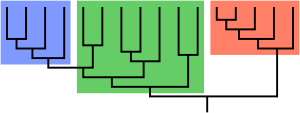Polyphyly


A polyphyletic group is an assemblage that includes organisms with mixed evolutionary origin but does not include their most recent common ancestor.[1] The term is often applied to groups that share similar features known as homoplasies, which are explained as a result of convergent evolution. The arrangement of the members of a polyphyletic group is called a polyphyly /ˈpɒlɪˌfaɪli/.[2] It is contrasted with monophyly and paraphyly.
For example, the biological characteristic of
Many
Etymology
The term polyphyly, or polyphyletic, derives from the two
and refers to the fact that a polyphyletic group includes organisms (e.g., genera, species) arising from multiple ancestral sources.Conversely, the term monophyly, or monophyletic, employs the ancient Greek adjective μόνος (mónos) 'alone, only, unique',[8][9] and refers to the fact that a monophyletic group includes organisms consisting of all the descendants of a unique common ancestor.
By comparison, the term paraphyly, or paraphyletic, uses the ancient Greek preposition παρά (pará) 'beside, near',[8][9] and refers to the situation in which one or several monophyletic subgroups are left apart from all other descendants of a unique common ancestor.
Avoidance
In many schools of
From a practical perspective, grouping species monophyletically facilitates prediction far more than does polyphyletic grouping. For example, classifying a newly discovered grass in the monophyletic family Poaceae, the true grasses, immediately results in numerous predictions about its structure and its developmental and reproductive characteristics, that are synapomorphies of this family. In contrast, Linnaeus' assignment of plants with two stamens to the polyphyletic class Diandria, while practical for identification, turns out to be useless for prediction, since the presence of exactly two stamens has developed convergently in many groups.[10]
Polyphyletic species
See also
References
- ISBN 978-0-134-09341-3.
- ^ "polyphyly". Oxford English Dictionary (Online ed.). Oxford University Press. Retrieved 28 December 2021. (Subscription or participating institution membership required.). [Source for pronunciation.]
- ISBN 9780231164122.
- PMID 33873498.
- OCLC 741613153.
- PMID 22486080.
- S2CID 195828782.)
{{cite journal}}: CS1 maint: multiple names: authors list (link - ^ OCLC 461974285.
- ^ a b c Bailly, Anatole. "Greek-French dictionary online". www.tabularium.be. Retrieved March 2, 2018.
- ^ Stace, Clive A. (2010). "Classification by molecules: What's in it for field botanists?" (PDF). Watsonia. 28: 103–122. Archived from the original (PDF) on October 15, 2012. Retrieved July 31, 2013.
- S2CID 40799805.
- .
- PMID 18677414.
- ^ Nixon, Kevin C., and Quentin D. Wheeler. "An amplification of the phylogenetic species concept." Cladistics 6, no. 3 (1990): 211–223.
- ^ Brower, Andrew V.Z., and Randall T. Schuh. 2021. "Biological Systematics: Principles and Applications" (3rd edn.). Cornell University Press, Ithaca, NY.
Bibliography
- ISBN 0-19-860426-2.
- "Evolution - A-Z - Polyphyletic group". www.blackwellpublishing.com. Retrieved 2018-02-24.
External links
- Funk, D. J., and Omland, K. E. (2003). "Species-level paraphyly and polyphyly: Frequency, cause and consequences, with insights from animal mitochondrial DNA" Annu. Rev. Ecol. Evol. Syst. 34: 397–423. at ftp://137.110.142.4/users/bhhanser/Subspecies%20general%20literature/FunkEtal2003AnnuRevEcolEvolV34pp397-423.pdf[permanent dead link]
